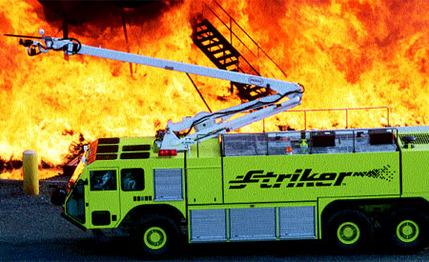
 Specialty File
Specialty File
Let's jam the piercing nozzle right into the master bedroom of that mobile home over there."
"Which one?"
"I like the chocolate-brown one."
"Fine. And then what?"
"Well, let's fill the whole room with foam, then maybe use the main nozzle to blow out all the windows, and, oh, by the way, can you set everything on fire?"
"I don't see why not."
At the Lake Superior College Emergency Response Training Center near Duluth, Minnesota, you get to do stuff like this all day. The instructors call it "practice." It's more like the raw material of adolescent male fantasies. The college possesses plenty of stuff to set alight: a DC-10 mock-up, a half-dozen Cessnas and Beechcrafts, three Coast Guard helicopters, five buses, a Cadillac Eldorado, a railroad tank car, a Great Lakes cabin cruiser, and a nice selection of mobile homes, whose aluminum exteriors and flammable interiors comprise a reasonable facsimile of commercial aircraft. At least when they're on fire.
This emphasis on aircraft accidents is no accident. The school specializes in ARFF training-that's Aircraft Rescue Fire Fighting. Right now, the most delectable ARFF truck on the planet is the Striker, built by the Oshkosh Truck Corporation in Wisconsin. It costs $675,000.
Think of the Striker as the Porsche 959 of firetrucks. For starters, all six of its wheels are driven. "When airplanes crash, they don't usually stay on the runway," explains Capt. Rex Weber of the Minneapolis-St. Paul International Airport Fire/Rescue Department. The Striker thus offers a 30-degree angle of approach and departure, and it can climb a 50-percent grade. It's designed to flatten trees and the standard chain-link fences that surround U.S. airports. It's 10 feet wide-with a monster track that helps keep it upright even when it's leaning 30 degrees to port or starboard. By firetruck standards, it's also quick. The FAA requires that ARFF trucks accelerate to 50 mph in 35.0 seconds and that, from the moment the alarm sounds, the truck is capable of reaching the midpoint of the most distant runway in no more than three minutes.
Which means the engine in this 40.05-ton colossus is itself a whopper: 15.8 liters of Caterpillar in-line six producing 650 horsepower at 2100 rpm and an orbit-altering 1950 pound-feet of torque at 1400 rpm-not much beyond a fast idle. The engine is rear-mounted, with a roof radiator as big as a mattress and a hydraulically driven fan that pulls cooling air from above. "You don't want the motor in front," reminds Weber, "because the action up there is gonna be warm." As it is, the Striker can idle hour after hour during a 125-degree day without overheating. This is a useful trait. During the 70 seconds it took to extinguish one particularly colorful practice blaze-a DC-10 engine fire-the truck's aluminum skin became so hot I couldn't hold my hand against it.
The Striker's payload is a 3000-gallon plastic reservoir, usually filled with water. There's also a 420-gallon tank that holds "aqueous film-forming foam"-essentially liquid dishwashing detergent. Combine the two and you have a slurry good for smothering fuel fires. This mixture can be blasted out of any of the truck's three spray guns-a 1200-gallon-per-minute roof turret, a 300-gpm bumper turret, and a 250-gpm piercing nozzle. Pump all three simultaneously and you can drain the main reservoir in less than two minutes. Which is why most ARFF trucks attend crash scenes with "nurse trucks" right behind, refilling the Striker's main tank again and again from astern.
The spray gun on the roof is affixed to an inordinately flexible cherry picker with a 50-foot vertical reach. Known as the Snozzle, it is an ARFF man's principal firefighting tool and can, all by itself, cost $150,000. Also at the Snozzle's tip dangles a camera that transmits images to the cockpit-either in color or in infrared black-and-white. The infrared images allow the driver to see through smoke. This camera is so sensitive that it can tell whether a plane is taking off or has just landed simply by monitoring the heat in its tires. Its main purpose, however, is to scan a plane's fuselage to search for hot spots, usually cargo fires. "If you find one," says Weber, "you pry open a hatch and poke the camera inside for a look first, before sending a firefighter in."